You’ll need to start slow with your combinations and add different shades gradually to make sure you get the right results here.
What colors make black? How to make black the easy way
Have you ever wondered what colors make black? For the non-artist, figuring out how to make black might not seem particularly important. As the darkest point of the color wheel, black’s various hues can be difficult to distinguish if you don’t have a particularly keen eye.
However, as creatives and painters will know, the right type of black can make all the difference to a project. Not all blacks are created equal, and simply dipping your brush into the darkest shade you can find won’t always be the right choice.
Learning how to make black, by matching equal amounts of various colors on the color wheel, can help to enhance the overall impact of your next creation.
Let’s take a closer look at what colors make black.
What is black? Defining how to make black
The first step in creating the ideal shade of black for your needs is understanding what black actually is. Black is the darkest hue we can perceive, created by a complete absence of light. It’s essentially the opposite of white, which appears at the other end of the spectrum.
In color psychology, black has a multitude of potential meanings. It’s a shade we often associate with power, dignity, and strength, as well as elegance and style. Black can be mysterious and foreboding, but it can also be a symbol of sophistication and beauty.
For creatives, black is a powerful tool. It can bring contrast to an image, help to balance an image with shading, and deliver visual depth.
However, it can be very difficult to mix the right shade of black from scratch. As many creatives discover, there’s more to it than simply mixing all the colors you can find into a murky mess.
Though mixing your own color combination to create black can be complex, it’s also a powerful strategy for artists. When you mix a color, you have more control over everything from the color temperature to the unique components of the black shade.
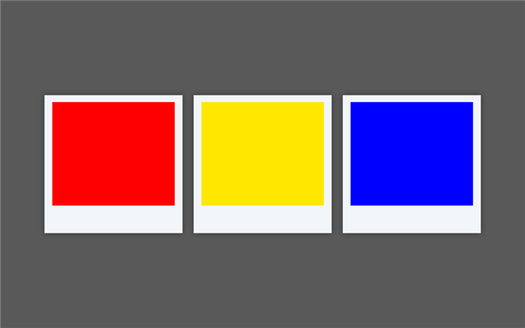
How to make the color black with primary colors
There are actually several color combinations which can work together to create black. Today, we’re going to be looking at different variations of black, from rich black, to cool black, and how you can build different colors on your palate.
One point to keep in mind is it’s very difficult to create true black or “perfect black” from scratch.
When you’re mixing colors, you’re likely to see a small amount of the most prominent shades in the palette shining through in your shade of black. This isn’t necessarily a bad thing.
Being able to adjust the darker shade you use in your artworks means you can play with contrast and light theory more effectively to create a unique result.
Let’s start with perhaps the simplesst way to make black. This will be a good option if you don’t have a lot of different shade variations in your pallete to begin with.
Combined together, red, blue, and yellow come together to create a specific shade of black. The good thing about using three different colors in your creation, is you can make slight changes to how people will perceive your shade of black, by adjusting the ratio.
Mixing equal shades of blue, yellow, and red will give you a balanced black shade, You should get a reasonably dark shade if you use equal proportions.
However, if you want a warmer black, closer to a sort of blackish/brown, you can use more of the red shade in your mix. If you’re hoping for a cooler black, you can add a little extra blue.
Notably, when experimenting with these primary shades, you might find you need to work with different combinations to get the darkest black depending on the medium you’re using. Mixing with acrylic paint is a very different experience to mixing with watercolors.
How to make black color – What colors make black?
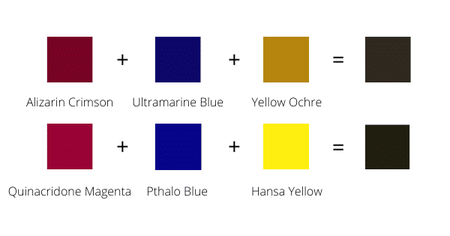
Creating shades of black color with primary colors
Red, blue and yellow are the three primary colors for what colors make black paint when mixed together. Simply mix equal amounts of red, blue, and yellow together and you will get a nice black. If you use a lighter red and blue you will end up with a brown – so be sure to use darker colors as shown in the color chart above. If you want the color of black to be a little more bluish, just add a little more blue to your color mixture.
For this initial black mixture, I recommend using the colors: Ultramarine blue for the blue, Alizarin Crimson for the red and Yellow Ochre for the yellow.
How to make black color using ‘printing primaries’
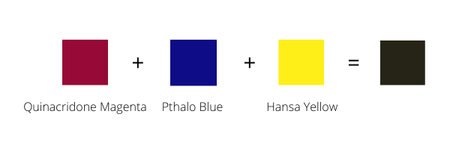
Quinacridone Magenta, Pthalo Blue and Hansa Yellow are very close to the ‘printing primaries’, which are the primary colors that are pretty much used by all the printing machines!
First mix the Phthalo Blue with the Quinacridone Magenta and you will get a good shade of purple. Then, add a little bit of Hansa Yellow to neutralize the color. Yellow is the complementary color of purple, so that is why the Hansa Yellow will neutralize the purple color and you will come out with a great black.
How to mix shades of black color using blue
There are more ways to mix black than with just primary colors. Here I will introduce three different mixtures you can use to make black using blue. Some are lighter, and others are darker – but they will all give you black!

First, we go over mixing Pthalo Blue and Cadmium Orange together. This mixture will create a lighter shade of black. So, if you ever want to have a lighter black without using white – this mixture is a good option! The Cadmium Orange will neutralize the Phthalo Blue and the Pthalo Blue will neutralize the Cadmium Orange since they are complementary colors. The resulting color will be a bit of a brownish-black.
This can make for an interesting color of black, especially if you aren’t wanting a very dark shade of black.
How to mix a dark black color
This is one of my favorite mixtures for how to make black paint color because it is so simple! Most artists almost always have Ultramarine Blue and Burnt Umber on their palette, as they are what make the color black a very dark shade!
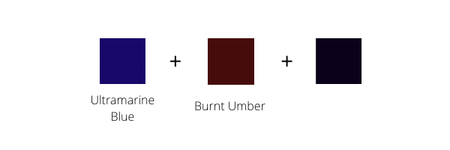
In addition to creating a dark black color, this color mixture creates a cooler shade of black due to the ultramarine blue in it. Ultramarine blue and burnt umber can actually be used to make cool dark colors in general. As well as dark shades of green when it is mixed with yellow. You can see such a greenish black in the painting below.
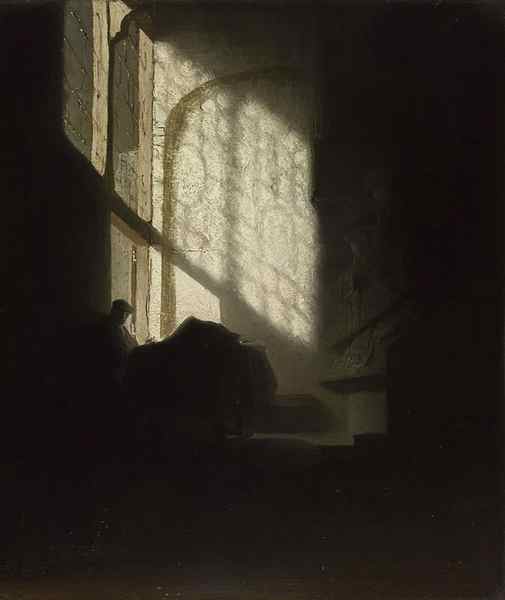
Mixing Blue with Burnt Siena for a warmer shade of dark black color
This mixture of Ultramarine Blue with Burnt Siena creates a warmer color than Ultramarine Blue mixed with Burnt Umber. Burnt Siena is a warmer color than Burnt Umber since it is a reddish earth tone.
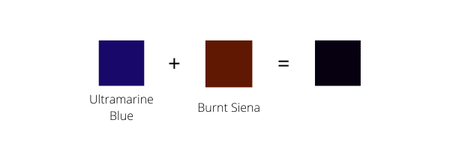
That said, this mixture is very similar to the black color mixture above with Ultramarine Blue and Burnt Umber. However, in addition to being warmer, Ultramarine Blue and Burnt Sienna, mixed together also create a lighter black.
Quick summary chart of what colors make black when using blue as the base color
Below is a chart of three different ways to mix black using blue. It is mainly blue mixed with different browns and cadmium orange.
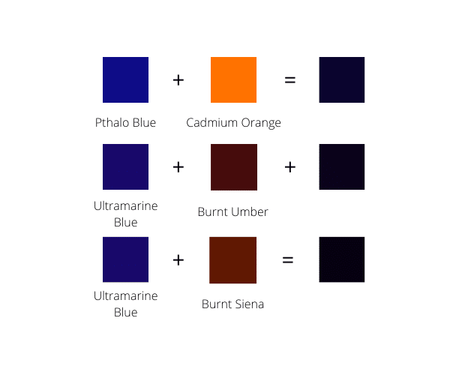
How to make shades of black with Pthalo Green
Pthalo Green is a very dark and rich color. For this reason it comes in handy for mixing different black colors. In fact, I use it to mix up one of my favorite black colors of all time – Pthalo Green + Alizarin Crimson.
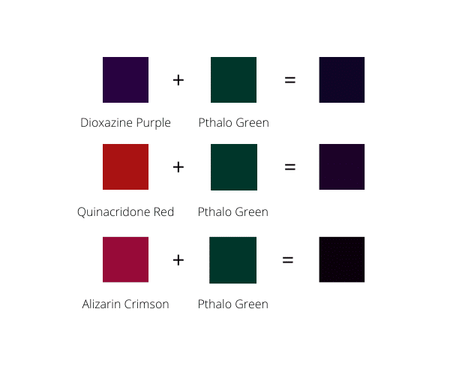
Mixing Pthalo Green with a rich dark purple color

First we will explore Dioxazine + Pthalo Green. It may come as a surprise, but purple and green mixed together can make a great color of black. Dioxazine Purple and Pthalo Green are both dark and create a rich dark black when mixed together.
However, since Pthalo Green is a very strong color, just make sure that the green does not overpower the purple. You can test out the color by testing it on a white surface and make sure that it is a black color and not green.
Mixing Pthalo green with red to make a deep black color
Above I showed how you can mix the complementary colors blue and orange together to make a black. Here, I am also again showing two complementary colors – red and green – and how they create black when mixed together.

You can’t mix any green and red together to get black. If you want it to be a good dark black then use Phthalo Green and Alizarin Crimson, both of these colors are dark versions of green and red and makes a rich deep black. In fact, this is one of my very favorite mixtures for black! As before, just make sure that you have equal amounts of the colors mixed together – you do not want to have more Alizarin Crimson than Pthalo Green or vice versa. You can test your mixture out on a white sheet of paper to make sure it is neutral enough.
How to mix a transparent black color

These two colors make for a great transparent black when mixed together, since both Phthalo Green and Quinacridone Red are transparent colors. However because of this, it is difficult to make a neutral grey with this color mixture.
An Exploration of the Color Black
Before we can get into the juicy part of this color mixing tutorial, it is important to have a broad understanding of black, how we perceive it, what it can mean, and why you should mix your own.

Black is Not a Color
Unlike all of the other colors of the rainbow, black is not technically a color. When we look at color scientifically and bear with us, each color that we can see with our eyes is a specific wavelength of visible light. Objects do not actually have any intrinsic color themselves, but the way that light interacts with them causes these specific wavelengths to bounce back into our eyes while others are absorbed by the object’s surface.
For example, a dainty blue flower absorbs most of the visible light wavelengths, but it reflects blue light back into our eyes, so we see the flower as blue.
The reason why black is so special is that it is not a wavelength of light, but the complete absence of any light. When we look at a black surface, there is no light being reflected back into our eyes because the surface is absorbing all the wavelengths of visible light. It can be confusing to think about this when we are talking about creating black paint, particularly because we do so by combining other colors.
Using Black in Your Work
Although technically not a color, black is an essential part of any painting or illustration. Black can be used in several ways, as a background color, to add dimension, or to add a particular mood or meaning to your designs. Just like any other color, there are several meanings and emotions that black can impart to your work, including a sense of mystery, sophistication, and mourning.
Associated with all things supernatural and otherworldly, black is a great color to use if you want to create a slightly uncomfortable or mysterious mood in your work.
We will go into more detail with regards to the different types of black you can use later, but the darker and cooler your black, the more mystery you can infuse into your designs. The color black is typically associated with the unknown, think a deep dark black pit or the endlessly dark night sky. Often, this association with the unknown can lead to black being associated with evil and death.

Black is the color of mourning. It is a long-standing human tradition throughout many cultures for a widow to wear nothing but black for an extended period of time following her husband’s death. The association between black and death goes even further, with almost all depictions of death, like the hooded figure with a scythe, being presented in black. As the opposite of the purity of white, black is often demonized and used to represent the negative side of everything, from race to morals or the “black sheep” of the family who does not fit in with the rest.
Although black has these potentially negative connotations, it is also one of the most sophisticated colors.
“Black tie events” are often the most classy and require the utmost sophistication and elegance. The concept of a “little black dress” as being one of the sexiest and elegant items of clothing for a person to wear also highlights this meaning of black. As a visually slimming color, black is one of the most popular colors in the fashion industry and interior design.
Why You Should Mix Your Own Black
Although most black shades tend to look the same, just like with any other color, there are different black shades and tones that you can create. It is because of this potential for variation that we believe every artist should know how to mix their own black. Some artists may tell you that mixing your own black is too much hard work and that it is easier to simply buy it in a tube, but we strongly believe that the variability in black shades is a wonderful way to make your work unique and full of life.

Now, we have to be honest with you here. It is unlikely that you will be able to mix pure black by hand, but this does not mean you will not be able to get close to the perfect shade. The black that you can create with your own hands will always be more vibrant and dynamic. Using your own black shades can help you put the vision in your mind’s eye onto the canvas with more precision and depth. When mixing by hand, you can create blacks that are very light or extremely dark. You can also make your black shade warmer or cooler by adjusting the ratios of your composite colors.
We are excited to share the different methods that you can use to mix your own black shades, so let us dive right in!
How to Make Black Paint
When it comes to the question of what colors make black, there are three main methods that give the best results. Within each of these methods, however, there are several tricks that you can use to subtly adjust your black shade so that you end up with the perfect black hue for your work. The first method for how to make black is to combine all three primary colors. The second method uses blue as a base color, and the third uses green.
If this is your first time mixing black paint, then we recommend grabbing a page of your sketchbook to create a record of these methods. For each method, you can draw a square for each component color and one for the black shade. These records can be helpful in the future.

How to Make Black with the Primary Colors
The first method we are going to discuss with regards to colors that make black is the primary shade method. For this method, all you are going to need is the three primary hues. These shades are blue, red, and yellow. This simple method requires equal amounts of each of these colors to produce a nice black shade. You can use this method with any paint medium, including watercolor, acrylic, and oil painting mediums.
While black is the darkest color we have, you can easily create different hues. The way that you can alter the shade of black is by using different shades of your primary colors.
Using lighter hues of your primary colors will create a lighter black shade that is almost brown. You can also alter the exact shade of your black by disregarding the equal parts ratio. A little bluer will make your black shade cooler, while a touch redder will do the opposite.
How to Make Black with Printing Primaries
Printing primaries are the primary shades used by printers. They make a great black, that is almost a pure black shade when combined. These three colors are:

The Hansa yellow is incredibly bright and quite a warm shade. Phthalo blue is also a bright shade of blue and leans a little more to the cooler side of the color temperature spectrum. Lastly, the Quinacridone magenta is a fairly muted, almost maroon shade of red, but it still retains a hint of vibrancy.
So, how do you make black with these three shades? We find the best way is to begin by mixing the magenta with the blue paint to create a nice warm and vibrant purple shade. You can then begin to add your yellow. Because yellow is the complementing shade to purple, it will cancel out the purple in this mixture leaving you with a lovely dark black hue.
The black shade that you get from this equal parts ratio is one of the closest shades to pure black that you can mix yourself.
How to Make Black with Other Primary Shades
If you are looking for a slightly more brown shade of black, then you can use the following primary shades:
In comparison to the printing primaries, these colors are slightly less vibrant. Yellow ochre is a little darker than Hansa yellow and already leans towards brown. Ultramarine blue is a little darker than Phthalo blue and leans a little more towards purple, making it warmer. Alizarin crimson is a lovely deep burgundy shade that also leans a little more towards purple, making it a cool red.
Begin, as with the last method, by combining the red and blue shades to create a purple. This purple is going to be quite dark. You can then add the yellow ochre to the purple mix to cancel it out and create your black paint.
As a result of the slightly more brown-yellow shade, this black has hints of brown, making it perfect for adding shadows and dimension to an object in your painting.
How to Make Black with a Blue Base
While you could happily spend your artistic career making black from the primary colors, there is so much more variety on offer. Blue, one of these primary shades, makes a fantastic base color for making a deep and cool black color. The exact shades of black you can make with this method depend on the exact shade of blue you use, and the other colors you choose to add into the mix.
Here, we are going to outline two different methods for how to make black with a blue base, but we encourage you to take this knowledge and keep experimenting to see how many unique black shades you can make!

How to Make Black with Phthalo Blue and Cadmium Orange
If you are wanting a light shade of black, that is almost like a dark grey color, then this is the method for you! With these two colors, you can create a light black without using any white.
The magic of this color combination lies in the mutual complementation of these two shades. Because each of these shades is so bright and vibrant, they neutralize each other very well. The vibrant Pthalo blue cancels out the vibrancy of the Cadmium orange, and vice versa. The final shade is a neutral and slightly brown light black color. This black is perfect for those looking to add shadow or those who do not want a very dark shade of black.
How to Make Black with Ultramarine Blue and Burnt Umber
If you want a much darker and cooler black shade, then this is the perfect combination of colors. This black shade would be perfect for a dark night sky or the depths of the ocean. Both of the component colors can be used extensively in color mixing to cool down and darken other colors.
Ideally, you want to use equal parts of each of these shades so that they cancel each other out perfectly, leaving you with a rich black shade. You can, however, experiment with altering the ratio of Burnt Umber and Ultramarine blue to create different shades of black.
Adding more blue will make your black even cooler, while more Umber will have the opposite effect and make your black a little browner.
How to Make Black with a Green Base
Maybe you have noticed that when you use white to lighten a store-bought tube of black paint, the grey can take on a slightly green tinge. The reason behind this process is because many commercial black paints are based on green pigments.
The key to making a beautiful dark black shade with a green base is, to begin with, a dark green. For all of our methods, we are using Phthalo green because it is a rich, cool, and very dark shade of green. We will be combining this green with purple, and two different shades of red to create a variety of black shades.

How to Make Black with Alizarin Crimson and Phthalo Green
In the primary color method, we used Alizarin crimson to make black. In essence, this method is the same as the primary color method, except you are condensing the yellow and blue into a single color. Just like blue and orange, red and green are each other’s complementing hues.
The most important part of using this set of colors that make black is the darkness of both the Phthalo green and the Alizarin crimson. Combine equal parts of each color and test your final shade of black on a piece of white paper.
This lovely and vibrant black shade has a hint of brown, but it is almost entirely masked by the darkness.
How to Make Black with Phthalo Green and Quinacridone Red
Again, the choice of red for this method is going to seem familiar because we used it in one of the primary methods. The result of this combination of colors is what we call transparent black because both of the component colors are transparent colors. As a result of this transparency, it is unlikely that you would be able to lighten this black into a neutral grey.
It will take a little patience to get this black mixture perfect, but the result is well worth the effort. This transparent shade of black is a very cool temperature and is also very close to the pure black you can buy in a tube.

How to Make Black with Dioxazine Purple and Phthalo Green
While the previous two color combinations may have made sense to you because they were fundamentally a combination of all the primary shades, the combination of purple and green may be a little more surprising. The magic of this combination lies in the darkness of the Pthalo green and Dioxazine purple.
Mix equal parts of each of these colors together and then test your black on a piece of paper. Because the green shade is such a forceful color, it may overpower the purple and you may have to add a little more purple to balance it out.
The black shade that you can create from these two colors is a beautiful, rich, and velvety dark color.
Adjusting the Temperature of Your Black
The three overarching methods that we have outlined in this article can be used to create a wide range of different black shades. Some of the black colors we have created are cooler and some are warmer, depending on the component colors. After you have mixed your shade of black, you can adjust the temperature a little more if that is what you desire.

How to Make Black Warmer
There are several colors that you can add to your black shade to make them a little warmer. We strongly caution that you only add a touch of these colors to your black at a time, as they can easily overpower the other component shades and you will no longer have black. Here are some of our favorite shades to use to warm up your black hues:
How to Make Black Cooler
Just as you can make your black warmer, you can also easily make it cooler by adding a small amount of cooler shades. These are some of the colors that you can use to cool down any black shade:
Now that we have come to the end of our tutorial on colors that can make black shades, we really hope that you feel more empowered to mix your own shades of black. The world of color is filled with unlimited possibilities, and black is just as variable as other colors.
Frequently Asked Questions
What Two Colors Make Black?
There are several different ways that you can make black from a range of colors. When it comes to what 2 colors make black, you have the option of using a dark green shade, like Phthalo green, combined with a red shade, like Alizarin crimson. You can also use a combination of a blue color, like Ultramarine blue, and an orange shade, like Cadmium orange.
How to Make Black Paint?
Say goodbye to the one-note tubes of black paint that you can buy at the shop. You can easily make your own black paint at home by combining a range of different colors. You can use a mixture of the primary shades, or use green or blue as a base.
Charlene Lewis ( Content Creator and Creativity Writer )
In 2005, Charlene completed her Wellness Diplomas in Therapeutic Aromatherapy and Reflexology from the International School of Reflexology and Meridian Therapy. She worked for a company offering corporate wellness programs for a couple of years, before opening up her own therapy practice. It was in 2015 that a friend, who was a digital marketer, asked her to join her company as a content creator, and this is where she found her excitement for writing.
Since joining the content writing world, she has gained a lot of experience over the years writing on a diverse selection of topics, from beauty, health, wellness, travel, and more. Due to various circumstances, she had to close her therapy practice and is now a full-time freelance writer. Being a creative person, she could not pass up the opportunity to contribute to the Art in Context team, where is was in her element, writing about a variety of art and craft topics. Contributing articles for over three years now, her knowledge in this area has grown, and she has gotten to explore her creativity and improve her research and writing skills.
Charlene Lewis has been working for artincontext.org since the relaunch in 2020. She is an experienced writer and mainly focuses on the topics of color theory, painting and drawing.
Learn more about Charlene Lewis and the Art in Context Team.





